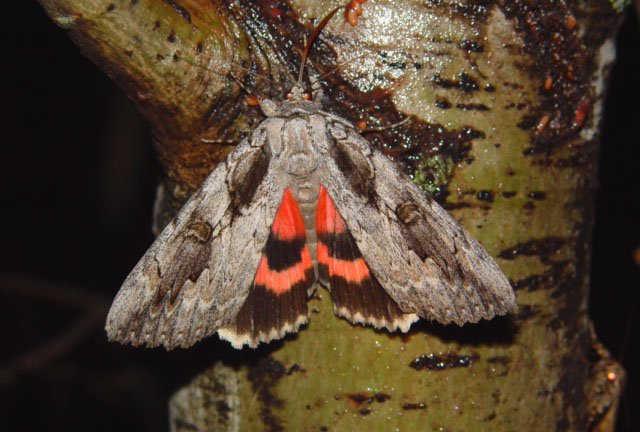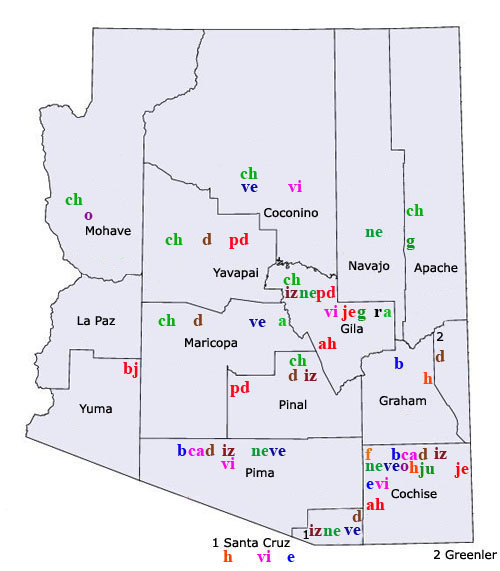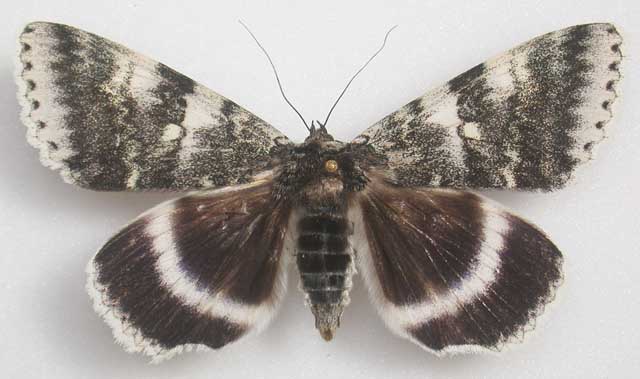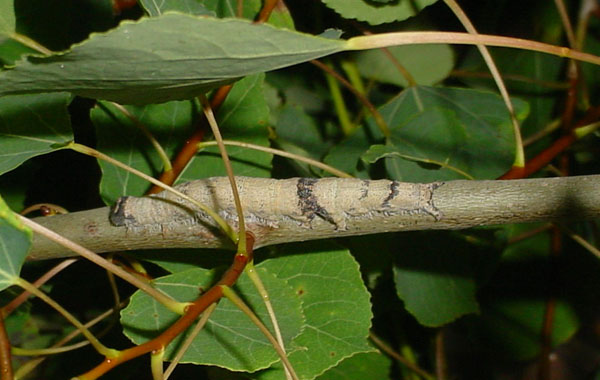
Most of the following information is taken
from Bruce Walsh (BW). His website is at
http://nitro.biosci.arizona.edu/zeeb/butterflies/nocut.html#Catocalinae
Lack of reporting for a particular county does not
indicate the species does not fly
there. Look at neighbouring counties or the entire Arizona list
to help identify a species. Most of the county information
is from Bruce Walsh's site and covers only Pima, Santa Cruz,
Cochise, Graham and Pinal.
Help with images or sightings (date/locaton)
would be greatly appreciated, even if it is just a confirmation of
what is already listed. Please send images and information to
Bill Oehlke


Catocala relicta, Payson, Gila County, Arizona,
August 26, 2006, courtesy of Kim Wismann.
Catocala benjamini jumpi flies in the Kofa Mountains.
I have indicated maximum and minimum known wingspans for each species and have put the different species into respective columns according to my interpretation of the hindwing colour. Framed specimens fade considerably when exposed to light. What one person sees as orange another may see as yellow! There is also some variation between live individuals.
Catocala larvae are mostly night feeders and are masters of camouflage. During the day they hide in the weeds and leaf litter near the base of the tree. In many case, under cover of darkness, they climb the tree and begin feeding after dark.

Catocala relicta courtesy of Bill Oehlke
As of April 4, 2010, this page has been further updated as per research data compiled by Larry Gall.
I would like to continue to refine the listings to county levels so images and data (date, location at least to county level,
bait, lights) would be very much appreciated. Please send same to Bill Oehlke.
All images that I use on my websites remain the property of respective photographers and images are credited as such.
The Identification Keys Diagram should help you understand the terminology I have used in describing the various species.
Visit Arizona Sphingidae: Hawk Moths/Sphinx Moths.
YELLOW | ORANGE | SALMON | RED |
SCARLET | PINK | BLACK | SPECIAL |
Yellow-Orange Underwings: Smallest to Largest
three miles north of Sunflower, Maricopa Co., June 21, 2011, of Evan Rand.
benjamini jumpi: Kofa Mountains, Yuma County.
several Onion Saddle, Chiricahua Mountains, Cochise Co., 27 July 2010, elevation 7600', Evan Rand 1 Copper Canyon, Huachuca Mountains, Cochise Co., 16 July 2010, Evan Rand 1 Madera Canyon, Santa Rita Mountains, Pima Co., 16 July 2010, Evan Rand
Cochise, Pima, Pinal, Santa Cruz; BW 2 Onion Saddle, Chiricahua Mountains, Cochise Co., 27 July 2010, elevation 7600', Evan Rand 1 Copper Canyon, Huachuca Mountains, Cochise Co., 24 July 2010, Evan Rand 1 Brown Canyon, Baboquivari Mountains, Pima Co., 30 July 2010, Evan Rand 1 Bear Canyon, Santa Catalina Mountains, Pima Co., 17 July 2010, Evan Rand
70mm, Pinal County, October 6, 2008, ER
Copper Canyon, Cochise County, 75mm, summer of 2009, Evan Rand. Bear Creek, Santa Catalina Mountains, Pima County, July 3, 2008, Evan Rand. Madera Canyon, Santa Rita Mountains, Pima County, July 31, 2007, Evan Rand. Madera Canyon, Santa Rita Mountains, Pima County, August 3, 2007, Evan Rand. Carr Cyn, 5500', Cochise County, Aug 7, 1999, Kelly Richers. 1 Copper Canyon, Huachuca Mountains, Cochise Co., 24 July 2010, Evan Rand. 1, Jct. of FR 49 and FR 812, Patagonia Mountains, Santa Cruz Co., 7 Aug. 2010, elevation 5100', Evan Rand. 2 Pinal Peak, Pinal Mountains, Gila Co., 28 Aug. 2010, elevation 7000', Evan Rand. 3 U.S. 60/77 milepost 320, Navajo Co., 19 Aug. 2010, Evan Rand. Orange-Salmon Underwings: Wingspans: 65mm, usually 70-95mm
at least 10 Pinal Peak, Pinal Mountains, Gila Co., 28 Aug. 2010, elevation 7000'; Evan Rand. Little Red Underwings: Wingspans: 39-55mm
Harshaw, Santa Cruz Co., July 9, 2008; Evan Rand Chiricahua Mtns, Cochise Co., July 3, 2010; Evan Rand. 1 Madera Canyon, Santa Rita Mountains, Pima Co., 16 July 2010; Evan Rand. three miles north of Sunflower, Maricopa Co., June 21, 2011, of Evan Rand.
Cochise; BW.
Large Salmon-Red Underwings: Wingspans: 70-90mm
8 Pinal Peak, Pinal Mountains, Gila Co., 28 Aug. 2010, elevation 7000', Evan Rand. Pinal Parks Rec Area, Gila County, September 9, 2011, Evan Rand.
Payson, Gila County, August 10, 2007, Evan Rand. Pena Blanca Lake, 3960', Santa Cruz Co, Aug 4 1999, Kelly Richers. Gila, ER many, Onion Saddle, Chiricahua Mountains, Cochise Co., 27 July 2010, elevation 7600', Evan Rand 1 Copper Canyon, Huachuca Mountains, Cochise Co., 24 July 2010, Evan Rand 2 Bear Canyon, Santa Catalina Mountains, Pima Co., 17 July 2010, Evan Rand 2 Pinal Peak, Pinal Mountains, Gila Co., 28 Aug. 2010, elevation 7000', Evan Rand 1, Harshaw Townsite, Patagonia Mountains, Santa Cruz Co., 2 Aug. 2010, elevation 4850', Evan Rand
Washington Park, Gila County, 75mm, June 12, 2010, 5800m, Evan Rand.
Medium-Large Pink Underwings: Wingspans: 70-95mm
Chiricahua Mtns, Cochise Co., July 3, 2010; Evan Rand
Large Black Underwings (Banded): Wingspans: 70-80mm
|
If you have additional sightings to add to the
list or high quality images of moths or larvae, please forward same
to
oehlkew@islandtelecom.com.
Images and/or information will be credited to photographer/source.
Records of Catocala specimens from different Arizona counties are listed below:
Apache
chelidonia | Cochise
aholibah ER | Coconino
chelidonia | Gila
aholibah ER |
Graham | Greenler | La Paz
mostly desert | Maricopa
amatrix ER, Aug |
Mohave | Navajo
| Pima
benjamini BW | Pinal
chelidonia |
Santa Cruz
desdemona | Yavapai
chelidonia | Yuma
benjamini jumpi |
|
Catocala electilis [ MONA 8831 ]
Counties: (Source: Larry Gall , pers. comm 2001)
Cochise
Santa Cruz
! Catocala amatrix [ MONA 8834 ]
Foodplants
Populus/Salix (L. Gall, pers. comm 2001)
! Catocala desdemona [ MONA 8835a ]
Taxonomy: C. benhamini is a full species, not a subspecies of C. delilah as listed in MONA (Dave Hawks, per com.)
Foodplants
Quercus (L. Gall, pers. comm 2001)
Catocala frederici [ MONA 8837 ]
Counties: (Source: Larry Gall , pers. comm 2001)
Cochise
! Catocala chelidonia [ MONA 8838 ]
Foodplants
Quercus (L. Gall, pers. comm 2001)
Catocala benjamini [ MONA 8849a ]
Taxonomy: C. benhamini is a full species, not a subspecies of C. andromache as listed in MONA (Dave Hawks, per com.)
Counties: (Source: Larry Gall , pers. comm 2001)
Cochise
Graham
Pima
Foodplants
Quercus (L. Gall, pers. comm 2001)
! Catocala verrilliana [ MONA 8852 ]
Foodplants
Quercus (L. Gall, pers. comm 2001)
! Catocala violenta [ MONA 8853 ]
Foodplants
Quercus (L. Gall, pers. comm 2001)
Catocala ophelia [ MONA 8854 ]
Counties: (Source: Larry Gall , pers. comm 2001)
Cochise
Catocala californiensis [ MONA 8862 ]
Evan Rand sends the following possibilities:
Cochise
Santa Cruz Co.
Gila Co.
Navajo Co.
All seem reasonable
Catocala frederici (probable) - 1 Onion Saddle, Chiricahua Mountains, Cochise Co., AZ - 27 July 2010, elevation 7600'
Catocala caesia? (very worn specimen, difficult to ID) 1, Pena Blanca Canyon, Atascosa Mountains, Santa Cruz Co., AZ - 20 July 2010
Catocala junctura (probable) - 1 Pinal Peak, Pinal Mountains, Gila Co., AZ - 28 Aug. 2010, elevation 7000'
Catocala hermia (probable) - 2 60/77 milepost 320, Navajo Co., AZ - 19 Aug. 2010
Return to Canadian Index
Return to Main Index
Enjoy some of nature's wonderments, giant silk moth cocoons. These cocoons are for sale winter and fall. Beautiful Saturniidae moths will emerge the following spring and summer. Read Actias luna rearing article. Additional online help available.
Eggs of many North American Saturniidae species are offered during the spring and summer. Occasionally summer Actias luna and summer Antheraea polyphemus cocoons are available. Shipping to US destinations is done from within the US.
This page is brought to you by Bill Oehlke and the WLSS. Pages are on space rented from Bizland. If you would like to become a "Patron of the Catocala Site", contact Bill.
Please send sightings/images to Bill. I will do my best to respond to requests for identification help.

|
butterfly to the left, a link to many worldwide insect sites. |